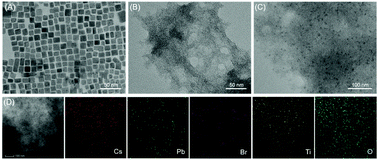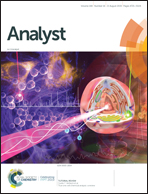Photoelectrochemical immunoassay of aflatoxin B1 in foodstuff based on amorphous TiO2 and CsPbBr3 perovskite nanocrystals†
Abstract
Aflatoxin B1 (AFB1) pollution is one of the most serious problems for food safety. In this paper, a split-type photoelectrochemical (PEC) immunoassay was designed for sensitive detection of AFB1 in foodstuffs by using amorphous TiO2 with all-inorganic perovskite CsPbBr3 nanocrystals (CsPbBr3/a-TiO2). The a-TiO2 layer not only improved the stability of CsPbBr3 nanocrystals, but also facilitated charge transfer, which resulted in the increasing photocurrent of the nanocomposites. Initially, a competitive-type enzyme immunoreaction was executed on a high-binding microplate between the analyte and alkaline phosphatase (ALP)-labeled AFB1-bovine serum albumin (AFB1–BSA) conjugate. Accompanied by the formation of the immunocomplex, the carried ALP triggered enzymatic hydrolysis to generate ascorbic acid (AA, as an electron donor) for increasing the photocurrent of the CsPbBr3/a-TiO2-modified electrode. Coupling with the competitive enzyme immunoassay, the photocurrent of the modified electrode decreased with the increase of target AFB1 concentration in a dynamic working range from 0.01 ng mL−1 to 15 ng mL−1 with a limit of detection (LOD) of 2.8 pg mL−1 under optimum conditions. Furthermore, the photoelectrochemical immunoassay was also utilized to detect AFB1 in peanut and corn samples, giving acceptable accuracy in comparison with the referenced AFB1 enzyme-linked immunosorbent assay (ELISA) method.



 Please wait while we load your content...
Please wait while we load your content...